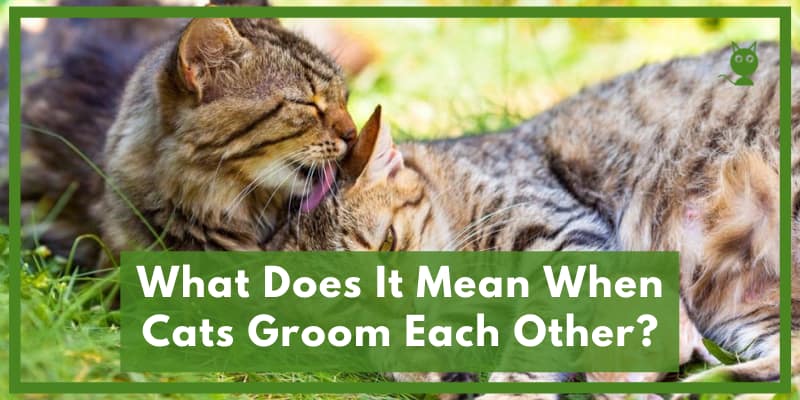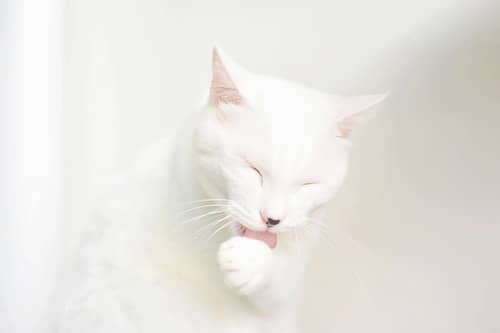
Domestic cats are meticulous about grooming. It is the main method they use to keep themselves clean. If you have owned a cat or two over the years, you would have noticed that they not only groom themselves but sometimes groom each other. What does it mean when cats groom each other? Well, that is a question that does not have a simple answer. Before we try to explain why cats exhibit this behaviour, we first have to take a look at the act itself and how it fits into the daily life of a cat.
The Two Different Forms of Cat Grooming

Cat grooming falls under two very distinct formats. There is autogrooming and allogrooming. Autogrooming is when a cat grooming itself. This is something cats learn when they are just kittens, and it becomes a part of their daily routine well into adulthood. Cats who autogroom will spend a great deal of time performing this important task and get very good at keeping themselves clean to where groomers or owners do not need to interfere. However, depending on the health of the cat, autogrooming activities may be reduced. This is common in cats suffering from arthritis which makes the act of autogrooming difficult or painful.
Allogrooming is when a cat grooms another cat. This is also very common and is typically displayed in homes with more than one cat. Allogrooming occurs in both domestic households and feral cat colonies. It is an act that also begins when the cat is a kitten with the mother cat responsible for initiating the routine. One interesting thing to keep in mind about cat grooming is that it serves far more than just cleaning. The activity is linked to social structure, dominance, and even relationships that are created between different cats. All of this comes from allogrooming with multiple cats engaging in the activity.
Licking - Why Cats Do It

To answer the question “What does it mean when cats groom each other?” we have to understand why they lick. If you have felt the tongue of a cat on your skin, you will recall that it felt rough. Some people describe it as having much the same texture like sandpaper. The tongue of a cat is lined with several tiny bristles. If you can imagine a piece of velcro with tiny hooks on it, you would be able to understand how the cat tongue works. As the cat licks its fur, the tiny bristles on the tongue act as a hairbrush that grooms the fur and pulls out loose hair, debris, and even tiny parasites.
If a cat does not lick, or groom, itself regularly, its coat can get dirty which may lead to matting or other issues. These issues include problems related to colony hierarchy, and even difficulties when hunting. On the other side of the coin is over-grooming, which also happens in cats. When a cat over-grooms, it can thin hair, cause patching, and the development of scabbing. Over-grooming is often the result of an underlying condition ranging from fleas and mites to allergies, arthritis pain, and hyperthyroidism. Over-grooming is something that should trigger a visit to the vet’s office for treatment.
What Does It Mean When Cats Groom Each Other? - How It Begins

So, how do cats learn to groom themselves and others? It starts soon after they are born. Kittens are both blind and helpless when they are born and this means they require constant care from their mothers. The mother cat will start licking her kittens right after they are born. The first order of business is to remove tissue and fluids from the kitten's coat to prevent the possibility of attracting predators. The licking action helps to stimulate the kittens, helps to dry their coats, encourages movement, and keeps them warm. The mother cat also grooms her kittens to clean them daily.
The mother cat also licks her kittens as they grow to stimulate urination and defecation. Because the cat family relies on shared space and shared scent, it only makes sense that they will also share behaviours and this is why other kittens in the litter will start to lick and groom each other. It is an act that is natural and necessary for their survival. Kittens that leave the litter too early, or are orphaned, suffer many issues. More often than not, they will be poor groomers. This is only because they did not have exposure to this from their mothers or other littermates while still very young.
Colony Hierarchy - Why Do Cats Groom Each Other Then Fight

When two adult cats are together, it is usually the most dominant of the pair that will groom the lower-ranking cat. Studies conducted on cat behaviour verify this and also indicate that when this occurs, the dominant cat will often just groom the less dominant cat around the face, neck, and head. As these are vulnerable regions, they are also targeted when cats engage in aggressive behaviour, including fighting. Researchers believe that higher-ranking cats groom lower-ranking cats as a way to show dominance without getting into a territorial battle of any kind.
When two adult cats are together, it is usually the most dominant of the pair that will groom the lower-ranking cat. Studies conducted on cat behaviour Fighting within a family unit is not typical if there is grooming activity. That is because all members of the family unit play specific roles such as hunting, providing territorial defense, and safety. A fight can cause an injury that would compromise a role in that family unit. This has led researchers to conclude that allogrooming is a method of keeping cats calm and preventing aggressive behaviours that could threaten the integrity of the family unit. In a multi-cat household, aggression occurs when access to such things as a litterbox or food is always shared and territorial instincts kick in.
How To Avoid Territorial Conflicts

Cats are territorial and in a multi-cat household, conflicts do occur. However, there are ways to reduce the likelihood of one developing by being aware of what conditions need to be avoided. Each cat requires a safe place to eat that is separate from where any of the other cats in the same home eat. There has to be more than one litterbox and bed. It is best to accommodate this by setting up different areas in either separate rooms or on different floors of the home. These safe places also have to be away from other household pets. By doing this, each cat will have less stress and this reduces aggressive behaviour.
More Interesting Data Cat Behaviour Studies

One more interesting fact to come out of research regarding how cats behave within a group showed that there is no preference in allogrooming between male or female cats when they have been spayed and neutered. However, if the female cats are left intact, studies show that there is an obvious increase in grooming habits with each other during the breeding season. Plus, larger breed cats tend to display their dominance over small cats far more frequently than they would towards cats of similar size. The data shows that the cat society has some complexities to it that help define family units and behavioural traits.
Cat Bonding And Adding New Cats To A Household

Adult cats that groom each other are often displaying a sign of affection towards each other. The way to recognize this is when allogrooming, the cats involved appear to be relaxed and enjoying the activity. But what if you introduce a new cat to the family? It is important to understand that a new cat will bring a new scent and different behaviours to the household. However, bonding can be encouraged if you neutralize the new scent. This can be done by using brushes and combs on all cats which will help them to be familiarized with the scents present and this will lead to bonding within the household.
The Problems That Come From Grooming

Probably the biggest problem to come from cat grooming is hairballs. A hairball is when either a longhair cat or a cat that grooms excessively ends up with an accumulation of fur in their stomach. Normally, a cat can pass the fur it ingests from grooming without a problem. However, there are times when too much of it gathers and sits in the stomach. When this happens, the lump of rough material in the fur causes the cat to vomit. Usually, this is in the form of a tightly bound mass of cat hair known as a hairball. Some medications and foods can help your cat pass hairballs easier preventing them from vomiting them up.
Cat Saliva And Disease

Two specific diseases can be carried in cat saliva. Feline Leukemia Virus can be passed from one cat to another in a shared environment. It has no cure but there is a vaccine that your vet can administer when your cat is young to protect it from contracting this viral disease. Feline Immunodeficiency Virus can be spread through cat saliva or blood. It tends to move within cat populations through bites suffered in catfights. There is no vaccine available for this disease. Although grooming is not how this disease commonly travels, it is important to monitor aggressive behaviour to control the spread of it.
Conclusion
The question was, “What Does It Mean When Cats Groom Each Other?” As it turns out, there are several answers to that. Grooming in cats is something that starts soon after a kitten is born and continues well into adulthood. Grooming is an important part of the social structure of a cat. It is also a practical activity. Not only does grooming clean a cat, but it helps cats to bond with each other. A cat that grooms another cat is performing an important ritual that also indicates affection. One thing is for sure, cats that groom themselves and others do so because it is something they learned as a kitten.






